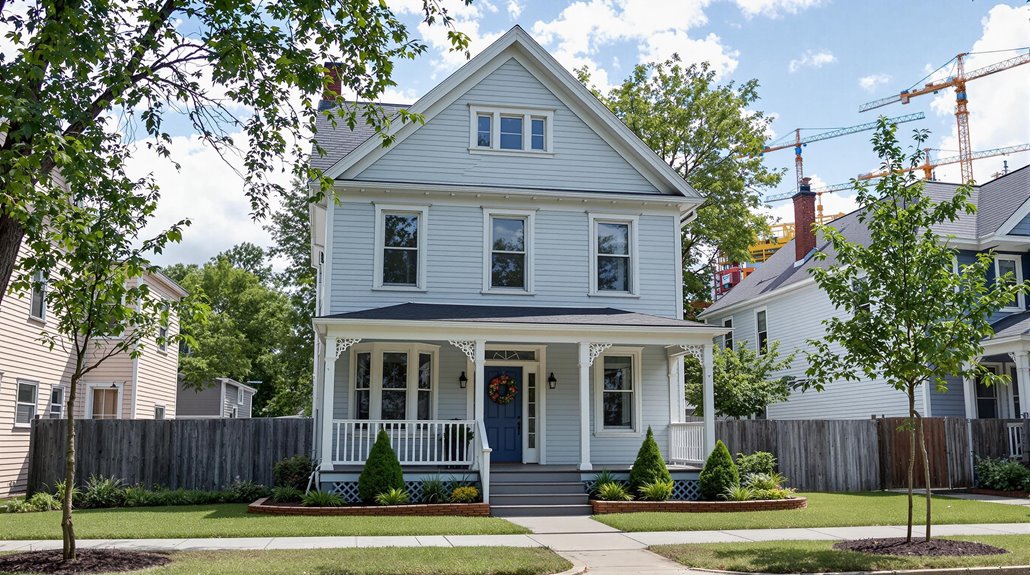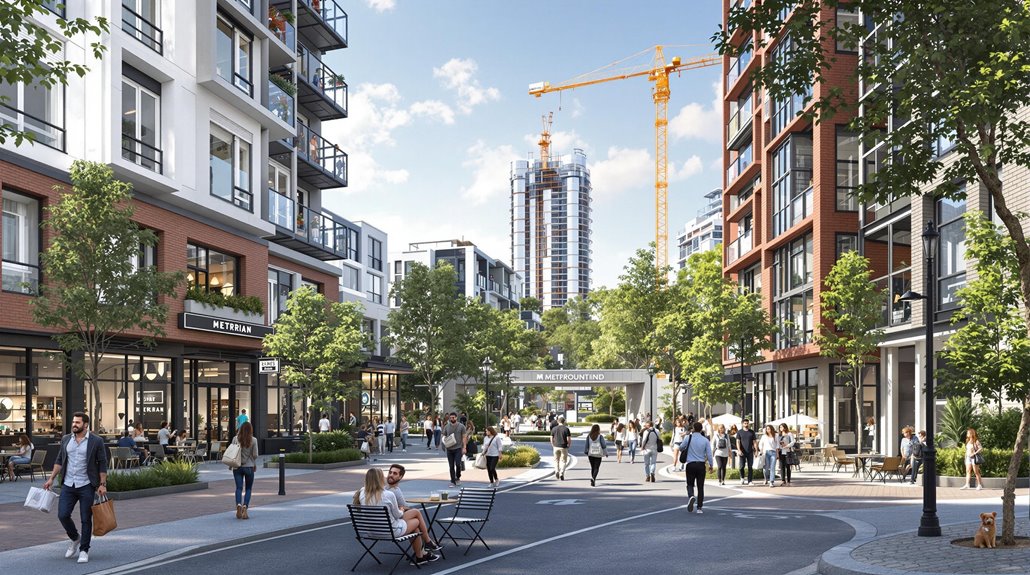How to Find a Good Investment Property? Focus on areas with strong rental demand and favorable rent-to-price ratios, aiming for 0.7% to 1%. Assess the property’s condition, neighborhood amenities, and future development potential. Analyze local market trends, job growth, and supply-demand imbalances to guarantee long-term cash flow and appreciation. Understanding these factors will help you make informed decisions and uncover deeper insights into maximizing your investment.
Key Takeaways
- Research neighborhoods with high rent-to-price ratios (0.7% to 1%) for strong cash flow potential.
- Prioritize areas with low vacancy rates and high contact-to-days listed ratios indicating strong rental demand.
- Assess property condition and potential appreciation by focusing on well-maintained or newer properties in growing areas.
- Leverage local amenities like parks, schools, and public transportation to attract tenants and enhance property value.
- Investigate future development plans and job growth trends to ensure long-term neighborhood growth and investment stability.
Evaluating Market Trends and Neighborhood Dynamics
Before you invest in a property, it’s crucial to examine the rent-to-price ratio, aiming for 0.7% to 1%, as this metric can signal whether a market offers potential cash flow. To know if rental property is a good investment, assess supply-demand imbalances by analyzing contact-to-days listed ratios; higher ratios indicate strong rental demand. When considering what to look for in an investment property, evaluate neighborhood characteristics like school ratings, crime rates, and amenities, as these factors directly influence tenant appeal and long-term value. Research job market trends using resources like the U.S. Bureau of Labor Statistics to identify areas with growing employment opportunities, which attract more tenants. Additionally, review future development plans through municipal planning departments. Ongoing construction often signals neighborhood growth, which can boost property values. Incorporate rental market analysis to further validate your investment by understanding rental price trends and affordability metrics. These steps help you gauge market dynamics and make informed decisions about potential investments.
Analyzing Cash Flow Potential and Rent-to-Price Ratios
Understanding cash flow potential starts with analyzing the rent-to-price ratio, a key metric for evaluating investment profitability. To determine a good investment property, you’ll want to ascertain the monthly rental income covers all expenses, including mortgage, taxes, insurance, and maintenance, leaving you with positive cash flow. A strong rent-to-price ratio, ideally between 0.7% and 1%, signals a higher likelihood of substantial returns. Use tools like Zillow’s rent Zestimate to quickly gauge rental income potential. Additionally, compare local market averages to assess competitive pricing and demand. Properties with low contact-to-days listed ratios often indicate higher tenant interest, which can stabilize your cash flow. For a comprehensive analysis, consider using a Long Term Rental Calculator to assess ROI and financial projections accurately.
Key Points to Contemplate:
- Aim for a rent-to-price ratio of 0.7% to 1%.
- Calculate total expenses to ascertain positive cash flow.
- Leverage tools like Zillow for quick rent and price estimates.
- Compare local market trends to identify strong opportunities.
Assessing Property Condition and Future Appreciation

While evaluating an investment property, it is essential to assess both its current condition and its potential for future appreciation. To determine if a rental property is a good investment, start by thoroughly inspecting its real estate investment property condition. Newer or well-maintained properties often require fewer immediate repairs and have higher long-term appreciation potential. Identify any necessary renovations early, as significant repairs can strain your budget and hinder appreciation. Research local market trends and historical appreciation rates, focusing on areas with consistent job growth and infrastructure development. Analyze the neighborhood for future development plans, as upcoming projects can boost values. Additionally, consider zoning regulations and how they may impact the property’s permissible uses, as flexible zoning can increase market value and appeal. Consider property tax data and school ratings, as desirable neighborhoods with reputable schools attract families and sustain property values. By carefully evaluating these factors, you can make informed decisions about a property’s condition and its capacity for future appreciation.
Identifying Supply-Demand Imbalances and Rental Demand
After evaluating a property’s condition and appreciation potential, you’ll want to assess the local rental market‘s supply-demand dynamics. Start by analyzing the contact-to-days listed ratio; a higher ratio indicates strong demand, as many renters are reaching out relative to the time a property has been on the market. Identify the “rent cliff,” where rental demand drops off sharply, and aim to purchase properties below this threshold. Investigate vacancy rates—low rates suggest healthy demand, allowing room for rent increases. Additionally, use platforms like Zillow to check the number of active listings; low numbers signal strong demand, while high numbers may indicate a declining area or seasonal cycle. Finally, monitor population and job growth in the neighborhood, as these directly influence rental demand and potential supply imbalances. Understanding tenant demographics can further enhance your ability to align property features with market demand. To check to see if a good investment property aligns with these factors:
- Analyze the contact-to-days listed ratio
- Identify the “rent cliff”
- Monitor local vacancy rates
- Track population and job growth trends
Leveraging Local Amenities and Future Development Opportunities

Why do local amenities and future developments matter when choosing an investment property? They directly influence tenant satisfaction, rental demand, and long-term property value, making them critical factors when deciding how to find rental properties to buy. Proximity to amenities like parks, restaurants, and public transportation attracts renters, while being near good schools can increase tenant retention and appeal to families. When learning how to find a good rental property, research future developments in the area, such as new businesses or infrastructure projects, as these often signal growth and rising property values. Check with municipal planning departments for upcoming projects and monitor vacancy rates to gauge market health. Emerging neighborhoods with new amenities often present opportunities for higher returns. By focusing on areas with strong local features and future potential, you guarantee your investment aligns with tenant preferences and market trends.
Conclusion
Finding a good investment property requires careful analysis of market trends, cash flow potential, and property condition. Focus on neighborhoods with strong rental demand and future development opportunities. Did you know that properties within a 10-minute walk of public transit appreciate 42% faster than those further away? By leveraging local amenities and identifying supply-demand imbalances, you’ll maximize returns and secure a resilient investment in a competitive market.




